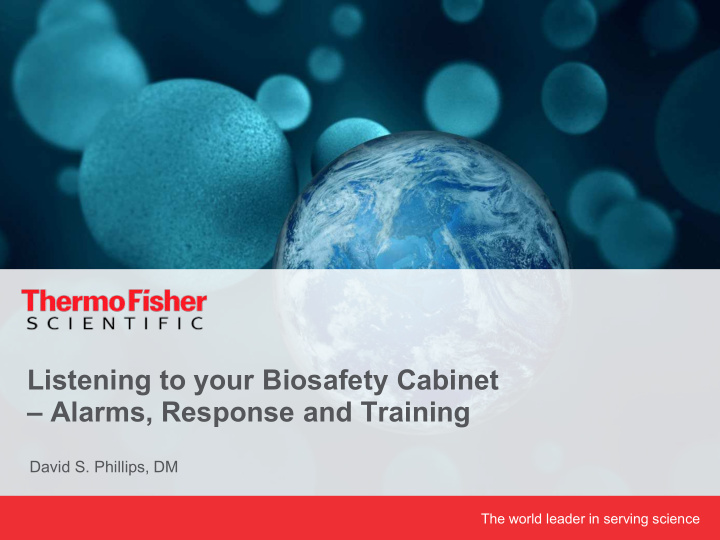



Listening to your Biosafety Cabinet – Alarms, Response and Training David S. Phillips, DM The world leader in serving science
Early BSC Controls and Display BLOWER CABINET OUTLETS CIRCUIT CIRCUIT BREAKER BREAKER LIGHTS 2
Pressure Gauges HEPA Filter Blower 3
Pressure Gauges – A question 0.65” 0.37” In a survey of the same 0.37” 0.50” model cabinet 0.66” 0.37” at a facility 0.55” 9 readings 0.40” 0.40” 0.37” to 0.66” w.g. 4
Pressure Gauges – Manufacturer Guidance • “When the reading increases by 50% from original measurement, cabinet airflow should be checked with a thermoanemometer. Replace the filters if proper airflow cannot be obtained.” ThermoForma 1284 • “The initial pressure reading will be approximately 0.5" w.g. + 0.1" w.g. depending on altitude from sea level. At each 0.1" w.g. increment increase, the cabinet airflow should be checked by a qualified technician, unless certified on a yearly (or sooner) basis.” NuAire NU425-400 Series 30 • “. . . check the reading on the analog pressure gauge; the displayed value should remain consistent with the recorded value in the most recent certification report. A significant change in pressure should be cause for investigation. This device is not intended to be used for air flow set-point verification.” Baker SG404 5
Example of current BSC interface Blower ON UV Light ON Blower pending Blower Alarm Light ON Outlets ON Alarms New Firmware Loaded Internal Board Failure Any alarm Power on Reset condition Airflow Pressure Alarm Blower RPM Failure Window High Window Low Replace UV Light 6
Example of current BSC interface 7
NSF/ANSI 49 Alarm and Interlock Requirements • Sliding Window Alarm • Audible and Visual - 1 inch (25 mm) above 1 inch (25 mm) below 8
NSF/ANSI 49 Alarm and Interlock Requirements • External Exhaust alarms • For B1 and B2 - Audible and Visual alarm and cabinet interlock shut- down within 15 seconds of exhaust volume loss exceeding 20%. • For Canopied A1 and A2 - Audible and Visual alarm within 15 seconds of a loss of capture of room air at the canopy air intake(s). Cabinet continues to operate. 9
NSF/ANSI 49 Alarm and Interlock Requirements • External Exhaust alarms Canopy • For B1 and B2 - Audible and Visual alarm and cabinet interlock shut- Gap down within 15 seconds of exhaust volume loss exceeding 20%. • For Canopied A1 and A2 - Audible and Visual alarm within 15 seconds of a loss of capture of room air at the canopy air intake(s). Cabinet continues to operate. 10
NSF/ANSI 49 Alarm and Interlock Requirements • External Exhaust alarms Canopy • For B1 and B2 - Audible and Visual alarm and cabinet interlock shut- Gap down within 15 seconds of exhaust volume loss exceeding 20%. • For Canopied A1 and A2 - Audible and Visual alarm within 15 seconds of a loss of capture of room air at the canopy air intake(s). Cabinet continues to operate. 11
Canopy Alarms Canopy Gap 12
BSC Alarm Overview 13
BSC Alarm Overview 14
BSC Alarm Procedures Do not make rapid movements Cover exposed materials Secure work area Close window Wash hands and clean up 15
BSC Alarm Procedures If not working with volatile toxic chemicals, you can continue working. Probably you will want to finish up because of the noise. 16
BSC Alarm Procedures If not working with hazardous materials, you should finish up within 5 minutes. If working with hazardous materials, Do not make rapid movements Cover exposed materials Secure work area Close window Wash hands and clean up 17
Suggestions • Quick Guide and Table of Responses External Exhaust (for fumes) Window Blower Blower Position (normal) (Stand-by) 18
Class II BSCs are great! “Why don’t I get a respirator?” Dave Phillips david.phillips@thermofisher.com 19
Recommend
More recommend